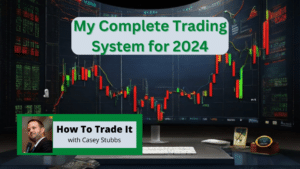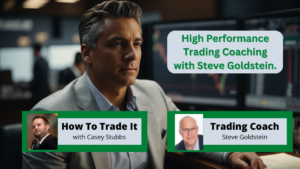Dan Passarelli’s Covered Calls Options Strategy, Ep #53
How do you make money with covered calls when the stock market is doing well? What is the best strategy to employ? How do you keep from losing consistently? Dan Passarelli set out to solve that problem for traders. In this episode of How To Trade It, we take a deep-dive into covered calls, a discussion of theta, time spreads, and much more. If you’re ready to take your options trading game to the next level—don’t miss it!
Subscribe to How To Trade It
[maxbutton id=”3″][maxbutton id=”4″][maxbutton id=”5″][maxbutton id=”6″]
You’ll want to hear this episode if you are interested in…
- [2:16] Diving into covered calls
- [5:49] The timeframe of Dan’s calls
- [7:08] A discussion of theta
- [11:50] The topic of time spreads
- [15:41] Determining mathematical edge
- [21:25] Expiration dates for time decay
- [23:59] How to manage risk appropriately
- [25:37] Dan’s favorite thing about trading
- [27:22] How to connect with Dan
How to find success with covered calls
Dan is quick to note that one strategy does not solve all problems. They’re all simply tools. Dan uses options for buying covered calls to short-term active earnings plays (time spreads held overnight). Different market conditions and different objectives direct what he does.
The goal should be to keep the money you make on the stop rising. Worst case scenario, you adjust the calls so you break even on the calls. When the stock is stagnant or falling, you’re keeping those premiums. If you sell a call for 75 cents and you have to buy it back for $1.50, you lost 75 cents. But if you sell another call and collect 75 cents, you break even and keep the value of your stocks.
Dan recently sold $3.91 calls. He sold them for 80 cents and bought them back at $1.20. So he was down 40 cents. But a week later he sold $3.96 calls and collected 70 cents. He got back the 40 cents and he’s up another 30 cents. Eventually, the market will go sideways or down and you can keep your premium. You will occasionally lose some on the calls. But you have to do covered calls repeatedly. In the long run, you will outperform.
What time frame does Dan prefer for calls? Listen to find out!
A discussion of theta
Theta is the rate of decline in the value of an option as the option expires. This comes in handy with covered calls, credit spreads, and iron condors. The best way to think about it is when you sell something, you want to sell it high and buy it back low. You want the option to lose value as fast as possible. Theta tells you how much the option loses each day by decay. You can make some better decisions and select optimal trades that benefit you more.
How do you use that criteria to pick a better option? It’s all relative to the stock choices you’re considering. Google stocks may have a theta of $2 a day. Ford may have a theta of a penny a day. The bottom line is, the higher the theta, the faster it loses value, and the more you can make.
*Special offer available ONLY for listeners of the How to Trade it Podcast*
Do you have a financial plan for the future? Investing in stocks may be the answer you are looking for. Dream Trades Monthly Alerts makes it super easy for beginners and removes the guesswork by providing you with a monthly in-depth analysis of a high-profile stock. In the last year, Dream Trades has gotten a 100% return on investment for everyone following the reports. Because you are a listener of the How to Trade It podcast, we are giving you a code for $25 off of a one-year subscription. Check it out at DreamTrades.com (click on “monthly alerts” and use the coupon code: podcast, to get $25 off).
The topic of time spreads
Covered calls work when you have shares of stock. When you don’t, credit spreads can be a good option. Time spreads are one of Dan’s favorites.
Whatever type of trade you’re doing, you should only make the trade when you have a statistical advantage. Time spread is when you buy a call and sell a different call with the same strike price—but less time until it expires. He might sell the $3.90 calls that expire in two days and buy the $3.90 call that expires in seven days.
Options with less time until expiration lose value faster than longer-term ones. So you get positive theta and make money every day in a hedged and controlled way. If the market doesn’t move, you’re in good shape. A small move in either direction doesn’t matter, you make that money on time decay. Time spreads can be powerful for range-bound assets.
How to determine if you have a mathematical edge
You have to look at implied volatility. It means how cheap or expensive the options are. If Goldman Sachs buys 5,000 of whatever option, they’ll get more expensive. If they sold 5,000 options, it would push the price down. Are they cheap or expensive compared to where they were in the past or where they should be?
On any option-friendly trading platform, you can look at the implied volatility figure for each option. It is a percentage, more specifically, the annualized standard deviation of the asset price. You look at these numbers and develop patterns. You want the implied volatility to be low.
When you buy an option, you want the price to be low. When you sell you want it to be high. With a time spread—because you’re buying one option and selling another—both can have a different implied volatility figure. Dan only selects time spreads when he can buy an underpriced option and sell an overpriced option relative to each other in one trade.
What expirations should a beginner shoot for? What time horizon do you pick? How much do you put into a trade? How do you stay consistent? Listen to the whole episode to hear what Dan recommends!
Resources & People Mentioned
- Special Offer: Try out group coaching for one month for just $0.99!
Connect with Dan Passarelli
- Market Taker Mentoring
- Market Taker Mentoring on Facebook
- Follow Dan on Twitter
- Connect on LinkedIn
- Watch on YouTube
Connect With Casey Stubbs
- Website: https://caseystubbs.com
- YouTube: https://www.youtube.com/TradingStrategyGuides
- YouTube: https://www.youtube.com/caseystubbs
- Twitter: https://www.twitter.com/caseystubbs
- Facebook: https://www.facebook.com/TradingStrategyGuides
- LinkedIn: https://www.linkedin.com/in/caseystubbs/
- Newsletter: https://tradingstrategyguides.ewebinar.com/webinar/live-workshop-learn-the-simple-baseline-strategy-13152
Subscribe to How To Trade It
Disclaimer: Trading carries a high level of risk, and may not be suitable for all investors. Before deciding to invest you should carefully consider your investment objectives, level of experience, and risk appetite. The possibility exists that you could sustain a loss of some or all of your initial investment. Therefore you should not invest money that you cannot afford to lose. You should be aware of all the risks associated with foreign exchange trading, and seek advice from an independent financial advisor if you have any doubts.







